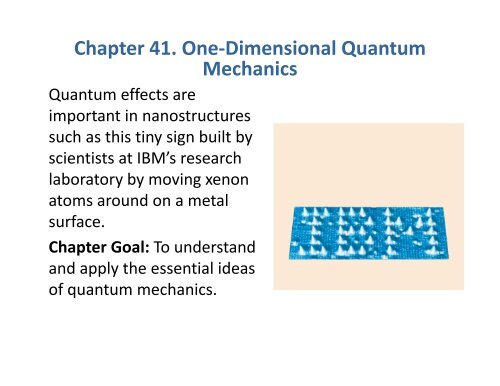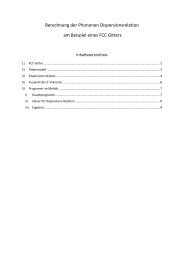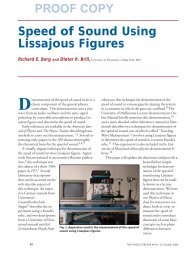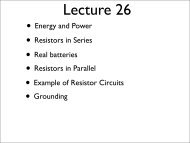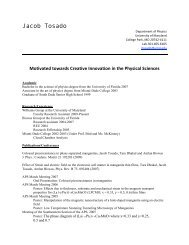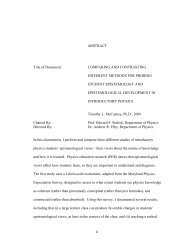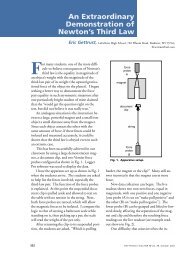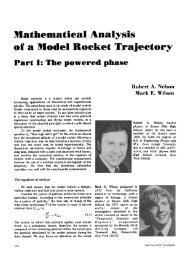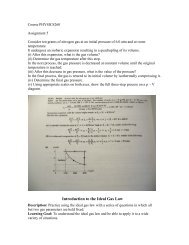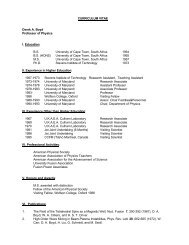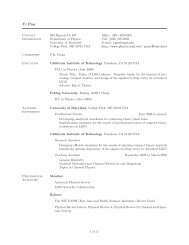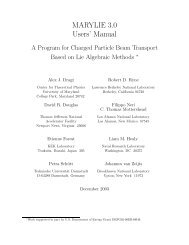Chapter 41. One-Dimensional Quantum Mechanics - Physics
Chapter 41. One-Dimensional Quantum Mechanics - Physics
Chapter 41. One-Dimensional Quantum Mechanics - Physics
You also want an ePaper? Increase the reach of your titles
YUMPU automatically turns print PDFs into web optimized ePapers that Google loves.
<strong>Chapter</strong> <strong>41.</strong> <strong>One</strong>‐<strong>Dimensional</strong> <strong>Quantum</strong><br />
<strong>Mechanics</strong><br />
<strong>Quantum</strong> effects are<br />
important in nanostructures<br />
such as this tiny sign built by<br />
scientists at IBM’s research<br />
laboratory by moving xenon<br />
atoms around on a metal<br />
surface. f<br />
<strong>Chapter</strong> Goal: To understand<br />
and apply the essential ideas<br />
of quantum mechanics.
<strong>Chapter</strong> <strong>41.</strong> <strong>One</strong>‐<strong>Dimensional</strong><br />
<strong>Quantum</strong> <strong>Mechanics</strong><br />
Topics:<br />
•Schrödinger’s Shödi ’ EEquation: ti Th The LLaw of f Pi Psi<br />
•Solving the Schrödinger Equation<br />
•AA Particle in a Rigid Box: Energies and Wave<br />
Functions<br />
•A Particle in a Rigid Box: Interpreting the Solution<br />
•The Correspondence Principle<br />
•Finite Potential Wells<br />
•Wave‐Function Shapes<br />
•The <strong>Quantum</strong> Harmonic Oscillator<br />
•More <strong>Quantum</strong> Models<br />
•<strong>Quantum</strong>‐Mechanical Tunneling
The Schrödinger Equation<br />
Consider an atomic particle with mass m and mechanical<br />
energy E in an environment characterized by a potential<br />
energy function U(x).<br />
The Schrödinger equation for the particle’s wave function<br />
is<br />
Conditions the wave function must obey are<br />
1. ψ(x) and ψ’(x) are continuous functions.<br />
2. ψ(x) = 0 if x is in a region where it is physically<br />
impossible for the particle to be.<br />
33. ψ(x) → 0 as x → +∞ and x → −∞. ∞<br />
4. ψ(x) is a normalized function.
Solving the Schrödinger Equation<br />
If a second order differential equation has two<br />
independent p solutions ψ ψ1(x) 1( ) and ψ ψ2(x), 2( ) then a general g<br />
solution of the equation can be written as<br />
where A and B are constants whose values are determined<br />
by the boundary conditions.
There is a more general form of the Schrodinger equation which includes<br />
time dependence and x,y,z coordinates;<br />
We will limit discussion to 1‐D solutions<br />
Must know U(x), the potential energy function the particle experiences as it<br />
moves.<br />
Objective is to solve for �(x) and the total energy E=KE + U of the particle.<br />
In ‘bound bound state state’ problems where the particle is trapped (localized in space), space)<br />
the energies will be found to be quantized upon solving the Schrodinger<br />
equation.<br />
In ‘unbound states’ where the particle is not trapped, the particle will travel<br />
as a traveling wave with an amplitude given by �(x)
E, KE, and and PE
E, KE, and and PE
The Schrödinger Equation with Constant potential
A Particle in a Rigid Box
A Particle in a Rigid Box<br />
Consider a particle of mass m confined in a rigid, one‐<br />
dimensional box. The boundaries of the box are at x = 0<br />
and x = L.<br />
1. The particle can move freely between 0 and L at<br />
constant speed and thus with constant kinetic<br />
energy.<br />
2. No matter how much kinetic energy the particle has,<br />
its turning points are at x = 0 and x = L.<br />
3. The regions x < 0 and x > L are forbidden. The particle<br />
cannot leave the box. box<br />
A potential‐energy function that describes the particle in<br />
this situation is
Zero point energy: even at T=0K, a<br />
confined particle will have a non‐zero<br />
energy of E1; it is moving
The Correspondence Principle<br />
When wavelength becomes small compared to the size of the box (that is, when either<br />
L becomes large or when the energy of the particle becomes large), the particle must<br />
behave classically.<br />
For particle in a box:<br />
Classically:
The Correspondence Principle<br />
When wavelength becomes small compared to the size of the box (that is, when either<br />
L becomes large or when the energy of the particle becomes large), the particle must<br />
behave classically.<br />
For particle in a box: Classically:
Finite Potential well:<br />
11. Solve Schrodinger’s Schrodinger s equation in the<br />
three regions (we already did this!)<br />
2. ‘Connect’ the three regions by using the<br />
following boundary conditions:<br />
1. This will give quantized k’s and E’s<br />
2. Normalize wave function
Finite Potential well:<br />
Finite number of bound states, energy spacing smaller since wave function more spread out<br />
(like bigger L), wave functions extend into classically forbidden region
Classically forbidden region – penetration depth
Finite Potential well example – <strong>Quantum</strong> well lasers
Finite Potential well example –1‐D D model of nucleus
Qualitative wave function shapes<br />
Exponential decay if U>E, oscillatory if E>U i.e. positive KE, KE~p 2 ~1/� 2 ,<br />
p y , y p , p / ,<br />
Amplitude~1/v~1/Sqrt[KE] (particle moving slower means more likely to be in that place)
Harmonic Oscillator<br />
11. Solve Schrodinger’s Schrodinger s equation in the<br />
three regions (we already did this!)<br />
2. ‘Connect’ the three regions by using the<br />
following boundary conditions:<br />
3. This will give quantized k’s and E’s<br />
g q<br />
4. Normalize wave function
Molecular vibrations ‐ Harmonic Oscillator<br />
E = total energy of the two interacting<br />
atoms, NOT of a single particle<br />
U = potential energy between the two<br />
atoms t<br />
The potential U(x) is shown for two<br />
atoms. There exist an equilibrium<br />
separation.<br />
At low energies, this dip looks like a<br />
parabola �� Harmonic oscillator<br />
solution.<br />
Allowed (total) vibrational energies:
Particle in a capacitor
Particle in a capacitor
Covalent Bond: H2+ (single electron)
Covalent Bond: H2+ (single electron)
<strong>Quantum</strong> Tunneling
<strong>Quantum</strong> Tunneling
<strong>Quantum</strong> Tunneling
<strong>Quantum</strong> Tunneling – Resonant tunneling


